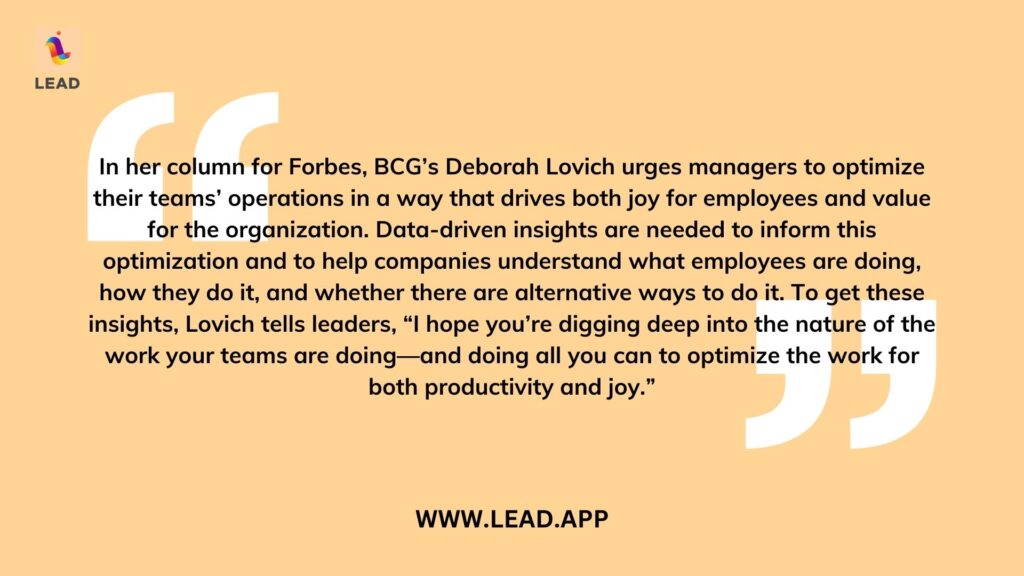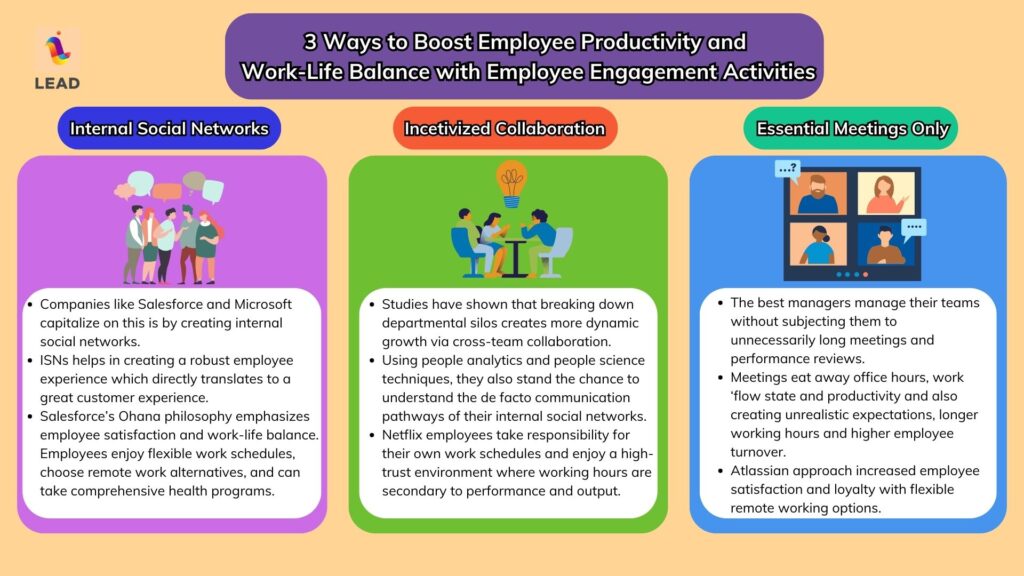Business productivity is going down! While companies scramble to find their footing on the fast-changing landscape of business meets AI, the overall global productivity values are dropping. In the middle of that, we are seeing a sizeable shift in employee management practices across the world. Gen Z wants different things from employers and there is a talent war going on to find and keep the best workers in every industry. And all of this is just the tip of the iceberg!
Suffice it to say, that there is no one giant pill that can make businesses turn the right corner on all of these issues. But the lynchpin behind all of these problems is the problem of managing people at work effectively. However since most of the mid-line managers are reporting they find meeting goals and nurturing talent difficult, something needs to change. And this is where creating a new mantra for work-life balance and boosting productivity comes in to sort the wedge.
Productivity Booms When People Thrive at Work
According to this Forbes article,
the idea of perfect balance can feel like a moving target, always just out of reach. Instead of exhausting yourself chasing balance, it may be more helpful to focus on managing your priorities as they shift. Accepting this natural ebb and flow takes the pressure off the impossible goal of perfect balance and lets you focus on what matters most in any given moment.
The hard truth is that work-life balance is hard to achieve for any company. What works better is to create employee engagement values and organizational cultures that make work easier and life happier. Here are 5 ways to create high productivity output and a good work-life balance with examples from real companies:
3 Ways to Boost Employee Productivity and Work-Life Balance with Employee Engagement Activities
Create Internal Social Networks
-
Companies like Salesforce and Microsoft capitalize on this by creating internal social networks.
-
ISNs help in creating a robust employee experience which directly translates to a great customer experience.
-
Salesforce’s Ohana philosophy emphasizes employee satisfaction and work-life balance. Employees enjoy flexible work schedules, choose remote work alternatives, and can take comprehensive health programs.
Adaptive sales funneling is the mantra of the new age. And the best way that companies like Salesforce and Microsoft capitalize on this is by creating internal social networks. The reason why this works is simple – salespersons and other technical staff connect with each other and organically create network churn within the company. In simpler words, people talk and connect within a company and create an organic communication flow. This helps in creating a robust employee experience which directly translates to a great customer experience. This streamlined throughput also marks the company as trusted both internally and externally. As a result, companies like Salesforce, which has a great employee engagement process, consistently rank not just in innovation but also in employee work-life balance. Here’s another example of internal social networks driving organic employee engagement values for real-time productivity boosting:
Unilever built its own system for this. They built a small application coupled with their internal social network that teaches people how to create their “personal mission statement.” As the company built out its Flex internal mobility and project system, the employee purpose profiles helped managers find people with different interests. These “belonging platforms” at work may do the same: teach people things about each other that really make work more fun and interesting.
Real Life Example: Salesforce
Salesforce is well-known globally for retaining a great work culture. Its Ohana philosophy emphasizes employee satisfaction and work-life balance. Employees enjoy flexible work schedules, choose remote work alternatives, and can take comprehensive health programs. Further, the company fosters an inclusive environment that nurtures both professional growth and personal well-being which in turn creates higher productivity margins via employee engagement for better sales and customer service values.


3 Ways to Boost Employee Productivity and Work-Life Balance with Employee Engagement Activities
Incentivize Collaboration
-
Studies have shown that breaking down departmental silos creates more dynamic growth via cross-team collaboration.
-
Using people analytics and people science techniques, they also stand a chance to understand the de facto communication pathways of their internal social networks.
-
A great example here is Netflix where employees take responsibility for their own work schedules and enjoy a high-trust environment where working hours are secondary to performance and output.
A great work culture begins when companies incentivize their employees to actively collaborate with each other. Studies have shown that breaking down departmental silos creates more dynamic growth via cross-team collaboration. When companies foster this kind of growth they also encourage talent nurturing through personal initiative.
Using people analytics and people science techniques, they also stand a chance to understand the de facto communication pathways of their internal social networks. This allows them to leverage their best-performing employees and help them discover their talents faster and more effectively. The result of this approach is better overall employee productivity and organizational growth leading to a healthy work-life balance. Here’s a BCG quote that perfectly encapsulates this perspective:
In her column for Forbes, BCG’s Deborah Lovich urges managers to optimize their teams’ operations in a way that drives both joy for employees and value for the organization. Data-driven insights are needed to inform this optimization and to help companies understand what employees are doing, how they do it, and whether there are alternative ways to do it. To get these insights, Lovich tells leaders, “I hope you’re digging deep into the nature of the work your teams are doing—and doing all you can to optimize the work for both productivity and joy.”
Real Life Example: Netflix
Netflix’s meteoric rise in the face of absolute behemoths like Disney and HBO is something of a legend in the business world. But it’s not surprising that it chalked up this much climb considering how it developed its organizational culture. Employees at Netflix take responsibility for their own work schedules and enjoy a high-trust environment where working hours are secondary to performance and output. This innovative way of creating employee engagement via supportive policies has been one of the biggest reasons why Netflix is now an online streaming services bracket leader.


3 Ways to Boost Employee Productivity and Work-Life Balance with Employee Engagement Activities
Kill the Meetings
- The best managers have learned to manage their teams without subjecting them to unnecessarily long meetings and performance reviews.
- Meetings eat away office hours, work ‘flow state, and productivity. This leads to unrealistic expectations, longer working hours, and higher employee turnover.
- While many companies resort to hawkish oversight via managers and team leaders but lower output, Atlassian’s approach increased employee satisfaction and loyalty.
Believe it or not, meetings are one of the biggest culprits when it comes to productivity drops among business teams. Everyone hates them and they often lead to more conflict than project streamlining. The best managers have learned to manage their teams without subjecting them to unnecessarily long meetings and performance reviews. The way this needs to work for any team department or even organizational culture is subjective. But one this is for certain more meetings do not produce more work value. In fact, the trend is decidedly in the opposite direction. Here’s a quote from a CEO magazine article to encapsulate this notion:
One major issue with the status quo meeting culture is leaders are in back-to-back meetings the entire day, shifting gears constantly, without any space for thinking, planning, actually getting work done, or being human. On top of that, the majority of meetings are disorganized and unproductive, lacking a meeting agenda or purpose, and without a structure and actionable takeaways.
Needless to say, meetings eat away office hours, work ‘flow state, and productivity. This leads to unrealistic expectations, longer working hours, and higher employee turnover. The better alternative is a scheduled working process that involves cliffnote-based meetings and collaboration-based status updates via Slack. This approach offers a more flexible work process and does not have managers breathing down their team members’ necks.
Real Life Example: Atlassian
Atlassian is a perfect example of what happens when smart team management meets dedicated remote workers. The company has a “Team Anywhere” initiative which enables employees to work flexibly from anywhere they like. While many companies resort to hawkish oversight via managers and team leaders but lower output, Atlassian approach increased employee satisfaction and loyalty.
How Should Your Business Boost Employee Productivity via Work-Life Balance?
LEAD bot is a team engagement platform for big businesses and MNCs on Slack and Teams. It is an all-in-one team development software with features like virtual coffee chats, buddy programs, birthday celebrations & work anniversary celebrations, new hire onboarding programs, and Pulse Surveys.
LEAD bot also offers cutting-edge Organizational Network Analysis (ONA) for large-scale organizations. C-suite execs and mid-level managers benefit greatly in their decision-making from ONA and use its highly actionable insights for building strong connections across their workforce. This enables far more forward-leaning talent development and generates greater organizational interconnectedness! Foster better organizational health, talent development, employee retention, and overall performance with this simple app!
LEAD bot is a product of LEAD.app and we also LEAD.bot’s sister app Sunrize which showcases workplace attendance by graphs right on Slack! Book a demo now!












